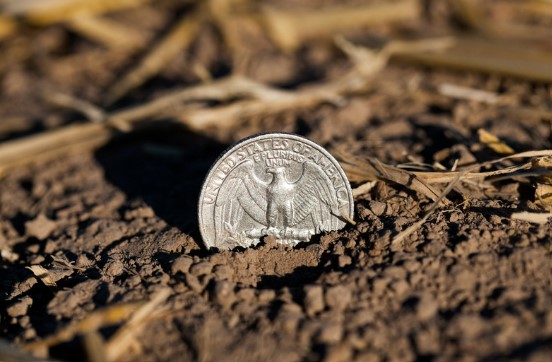It is really fascinating that you will find the most coins underground and not on the surface with your metal detector. There are many people who are wondering why most of the old coins they found were buried under the ground.
This is a frequently asked question in the metal detector world and there are several reasons why a coin gets buried under the ground over the time.
But what is the reason that you will find old coins mainly underground and not on the surface?
Old coins are often found underground because they have been subjected to sedimentation processes over a long period of time. The following factors can contribute to burying a coin underground:
- Sedimentation of aeolian sand.
- The compost from crops.
- Fertilizer/manure.
- The combination of gravity and rain.
- Plowing the ground with a tractor.
- The remains of leaves and branches from trees.
- A slope of the surface, that produces flowing mud and sand.
- Thawing and freezing of the ground.
- Roots of crops.
In this article I will explain you all the factors that influence the burial process of an old coin in detail. You should definitely read this article if you are interested in the reason why the most coins are found on a certain depth in the ground.
The sedimentation of aeolian sand
Sand transported by the wind is called aeolian sand, and it’s one of the reasons why coins get covered with layers of sand over time. Eroded sand grains are carried by the wind and deposited in areas where the wind speed is low, such as a field.
When this process continues for decades, a thin layer of sand can accumulate on the field, causing coins to sink deeper and deeper into the ground.
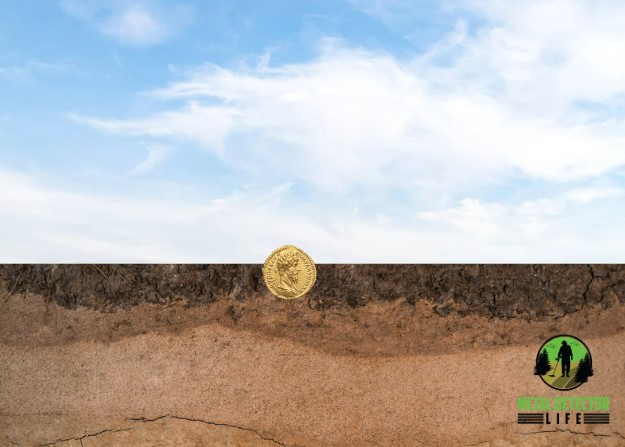
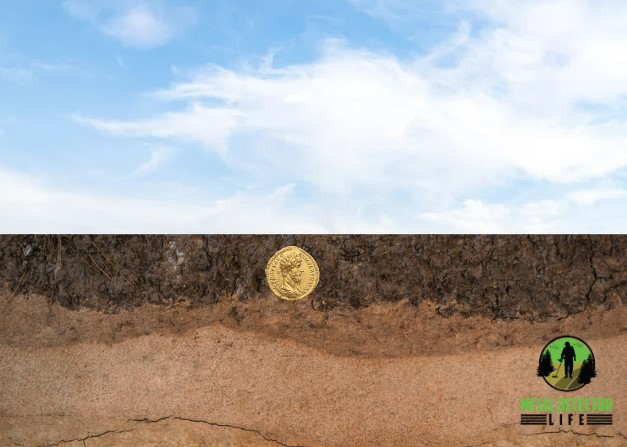
Notice that places with a low windspeed will have more sedimentation of aeolian sand. Also, places near to beaches or deserts will have more sedimentation of aeolian sand.
At these places, the coin will be covered deeper than at other places. Later in this article, I will explain in detail the factors that determine how deep a coin is buried in the ground.
The compost from crops
The end of a harvest season leaves behind the remains of crops on the surface of a field. As this organic material rots, it creates compost that eventually turns into a sort of potting soil.
This process repeats year after year and can result in a layer of compost forming on the field, which can hide a coin over time
Fertilizing a field
Farmers often fertilize their field to make sure that their crops are growing fast enough. When they fertilize their field, manure or fertilizer will be spread out over the land surface.
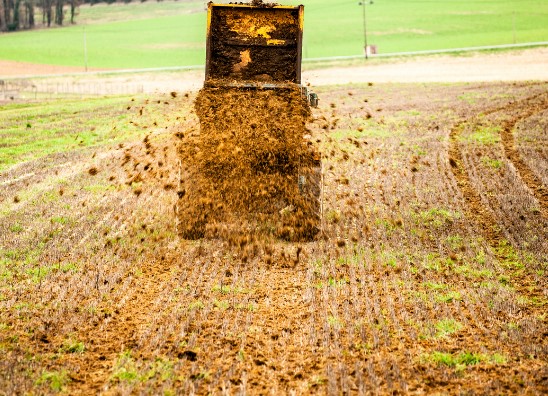
Coins can get buried by this manure or fertilizer. When this process happens several times during the year, the coin will be buried deeper and deeper.
Gravity in combination with rain
After rainy days, the soil can become muddy and waterlogged, making it more permeable. As a result, the coin can sink deeper into the ground under the influence of gravity and the porous soil.
The orientation of the coin can also affect its sinking depth. Coins placed vertically are likely to sink more easily than those placed horizontally because they have less friction with the soil.
Plowing the ground with a tractor
During the period between the harvest and sowing season, a farmer typically plows the field to improve drainage, aerate the soil, and prevent weed growth.
However, when a tractor plows the ground, sand from deeper layers of the soil can be thrown onto the surface of the field. If this sand lands on a coin, it can effectively bury the coin and cause it to sink deeper into the ground.
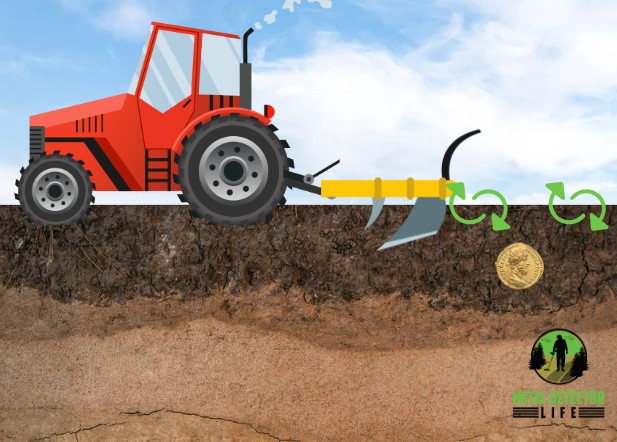
When this process happens year after year, the coin will be buried deeper and deeper. However, there are also situations where a coin can be brought up to the surface by plowing the field. This is why it is a good idea to go metal detecting after a farmer has plowed their land.
Roots of crops and freezing and thawing of the soil
Roots of crops can cause a little expansion of the soil. There is a possibility that sand will be moved by this. When the sand lands on a coin, the coin can be covered. If this process continues for years, the coin can be buried deeper and deeper.
The roots of crops can also ‘push’ the coin further into the ground. Of course, this effect will be minimal, but it can happen. Moreover, the freezing and thawing of the soil can cause an expansion and shrinking effect, which can move the coin.
The presence of trees around a field
When there are a lot of trees around a field, the leaves and branches of the trees will cover the surface of the field during autumn. When this happens every year, a little layer can be created by the remains of these leaves and branches.
This layer can eventually hide a coin from sight and bury it deeper into the ground. Additionally, trees can also cause a shifting of the soil due to their roots, which can further bury the coin.
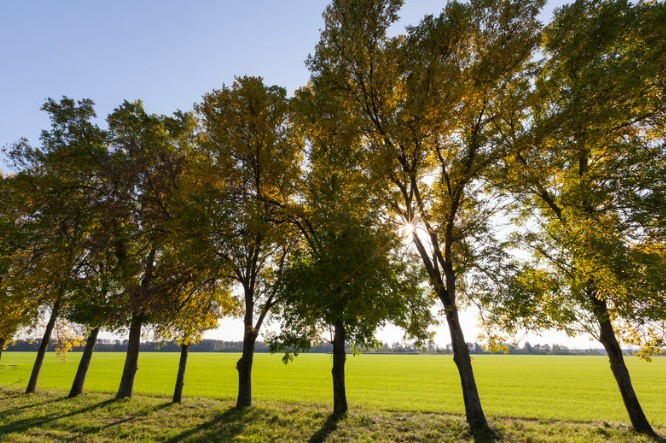

The influence of a slope of the surface
During a rainy day, mud and sand can flow to a lower part of the field when the field has a slope. When your coin is located at this lower part, it can get covered with mud and sand.
Always be aware of surface inequalities in these areas! If you want to know more risks during metal detecting, you should read my blog about the dangers and risks during metal detecting.
Spreading waste over the land surface
This is especially important for really old coins. Back in the days, people used hay as floor in the house. After a while, this dried grass had to be replaced. The people threw it on the surface of a field when they had to get rid of it. This could have covered coins.
Why is one coin deeper located in the ground than the other?
It might be possible that you found a really old coin very close to the surface while you also found a modern coin on another field that was much deeper located. How is it possible that a modern coin is deeper located than an old coin?
The soil structure determines the depth of a coin. Clay grounds are less permeable than a gravel ground for example. A coin won’t easily sink through a clay layer while a coin will easier sink through sand or gravel grounds under the influence of rain and gravity.
The level of the sedimentation of sand and the presence of trees will also play a role in the burial process. Last but not least, the slope of a field will have a major influence on the level of coverage. When a field has a slope, mud and sand will flow to the lower part. If your coin is located at the lower part, it will be covered with sand and mud.
Permeability of the ground
The following table shows the permeability of different bottom types. Remember that you will probably find a coin closer to the surface in a bad permeable bottom. You will probably find a coin deeper in a good permeable bottom.
| Bottom Type | Permeability (ft/day) |
|---|---|
| Gravel | 3.000 |
| Coarse sand | 100 |
| Fine sand | 15 |
| Peat | 0.15 |
| Clay | 0.05 |
The level of sedimentation
As mentioned before, coins can get covered with aeolian sand. Places near to beaches or places with a low windspeed will be covered sooner with aeolian sand than other places. This might be the reason why a coin is buried deeper at a location near the beach compared to another location with lower aeolian sand coverage.
The presence of trees
As said before, the presence of trees can have an influence on the coin depth. A field near to a lot of trees can have a layer of the remains of the leaves and branches of a tree, which can increase the coin depth.
The presence of trees can cause regional differences in coin depth because there are a lot of differences in the amount of trees between fields.
The slope of the bottom
When a certain field has a slope, mud and sand will flow to the lower part of the field during heavy rain showers. This means that the coin will be covered with mud and sand when it is located at the lower part of the field.
Coins located at the lower part of the field will be buried deeper than the coins located at the higher part of the field. This causes huge differences in coin depths between fields.
Frequently Asked Questions
The most coins will be found at 4-6 inches deep (10-15 centimeter). This depends on the specific location.
Old coins have been under the influence of sedimentation processes for a really long time. Sand, compost, fertilizer/manure and mud have covered the coins.
When a certain field has a slope, mud and sand will flow to the lower part of the field. When the coin is located at the lower part, it will be covered with a lot of sand compared to the higher part of the field. Also, the presence of trees and the level of sand sedimentation can cause differences between coin depths.

